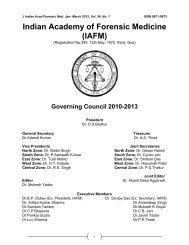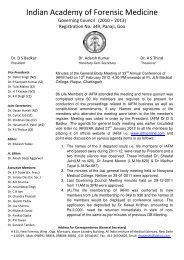Journal of Indian Academy of Forensic Medicine (JIAFM)
Journal of Indian Academy of Forensic Medicine (JIAFM)
Journal of Indian Academy of Forensic Medicine (JIAFM)
Create successful ePaper yourself
Turn your PDF publications into a flip-book with our unique Google optimized e-Paper software.
50<br />
<strong>JIAFM</strong>, 2007 29 (2) ISSN: 0971-0973<br />
Electrocution: A Six-Year Study <strong>of</strong> Electrical Fatalities<br />
*Manish Shrigiriwar, M.D., **Rajesh Bardale, M.D., ***P. G. Dixit, M.D.<br />
*Associate Pr<strong>of</strong>essor<br />
**Lecturer<br />
***Pr<strong>of</strong>essor & Head<br />
Department <strong>of</strong> <strong>Forensic</strong> <strong>Medicine</strong>, Govt. Medical College, Nagpur, Maharashtra (India)<br />
Corresponding Author:<br />
Dr Manish Shrigiriwar<br />
Plot No. 5, Ayodhya Nagar, Nagpur, Maharashtra (India) PIN: 440024<br />
E-mail: amanshreemanishmansi2000@ yahoo.co.in<br />
Abstract<br />
A six-year study, from January 2001 to December 2006, was undertaken in an attempt to study the pattern <strong>of</strong><br />
electrical injuries, the cause <strong>of</strong> death, manner <strong>of</strong> death and the importance <strong>of</strong> histopathological examination. The<br />
study was comprised <strong>of</strong> 86 cases brought with history <strong>of</strong> electrocution, consisting <strong>of</strong> 69 men and 17 women. Their<br />
age ranged from [3] year to [65] year. We had found 97.67% cases <strong>of</strong> accidental death and 2.32% cases <strong>of</strong><br />
homicides. Accidental death was more common in age group 21 to 30 years. Of all cases, 45.34% cases were <strong>of</strong><br />
electric contact, 31.39% cases were <strong>of</strong> contact and heat and 9.30% cases were <strong>of</strong> flash burns. In [6] cases no<br />
electric mark could be identified. With reference to occupation, 20.93% <strong>of</strong> deaths occurred in labor class.<br />
Considering the histopathological changes, nuclear streaming, dermo-epidermal separation and coagulative<br />
necrosis were amongst the commonest lesions.<br />
Key Words: Electrocution, Electric Burns, Joule Burns.<br />
Introduction:<br />
Electricity means power, energy and rhythm for<br />
today's life, without electricity existence <strong>of</strong> human life<br />
seems difficult, but it has also capacity to make life<br />
stand still culminating in to death, the black side.<br />
Nevertheless, the fatalities caused by electricity are<br />
a preventable form <strong>of</strong> injuries still, the toll continues.<br />
Unfortunately in developing countries like India<br />
where awareness is less and electric<br />
equipment/instruments are not used as per<br />
standards laid down and cheap alternatives are<br />
easily available at lower cost, costing the lives, the<br />
death due to electrocution heaps up.<br />
Most <strong>of</strong> the times, the forensic pathologist is able to<br />
diagnose the electric injuries when typical marks are<br />
produced. However, at times he may face difficulty<br />
and in such situations laboratory and circumstantial<br />
evidence are important. Moreover, in India most <strong>of</strong><br />
the reliance is placed on medical jurist's opinion<br />
where he has to use available resources to form an<br />
opinion. This study was undertaken in an attempt to<br />
study the pattern <strong>of</strong> electric injuries, the cause <strong>of</strong><br />
death, the manner <strong>of</strong> death and the importance <strong>of</strong><br />
histopathological findings in electrocution cases.<br />
Method:<br />
The present study was carried out at Govt. Medical<br />
College, Nagpur during January 2001 to December<br />
2006. All the cases <strong>of</strong> electric shock reported have<br />
been evaluated. A standard pr<strong>of</strong>orma was designed<br />
to ensure consistency for the whole sample. The<br />
format includes age, sex, place <strong>of</strong> death, occupation,<br />
medical attention received, cause and manner <strong>of</strong><br />
death, consumption <strong>of</strong> intoxicating substance and<br />
histopathological findings.<br />
Observation:<br />
A total <strong>of</strong> 86 cases were studied, brought with<br />
history <strong>of</strong> electrocution, out <strong>of</strong> which 69 were male<br />
and 17 were females and their age ranged from [3]<br />
year to 65 year. Age wise distribution is as per table<br />
No.1. Of the deaths, 66 cases were due to electrical<br />
injuries, [8] deaths due to septicemia, 5 deaths were<br />
due to head injury and one death due to head and<br />
chest injury. With reference to the electric injury, the<br />
injury with electric contact alone was seen in 39<br />
cases (45.34%), contact and heat in 27 cases<br />
(31.39%) and flash burns in 8 cases (9.30%). As far<br />
as flash burns were considered, the burn percentage<br />
varied from 30% to 66% with mean 47.37%. In [6]<br />
cases no electric marks were found.<br />
As with the manner <strong>of</strong> death, we had found 84<br />
(97.67%) cases <strong>of</strong> accidental death comprising 69<br />
(80.23%) males and 15 (17.44%) females and [2]<br />
(2.32%) cases <strong>of</strong> homicides, both were females and<br />
no case <strong>of</strong> suicide. Comparing with the age group<br />
(Table No.2), accidental death was more common in<br />
age group 21 to 30 year and least in age group 61 to<br />
70 year (one case). In the present study, 43 (50%)<br />
deaths occurred at work place consisting <strong>of</strong> 42 male<br />
and 1 woman; where as 43 (50%) deaths occurred<br />
at home, comprising 27 males and 16 females. With<br />
reference to the occupation (Table No.3) it was<br />
noticed that maximum number (18 deaths, 20.93%)









